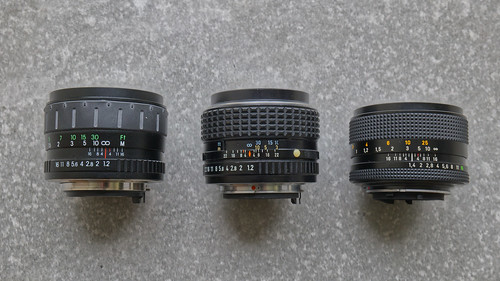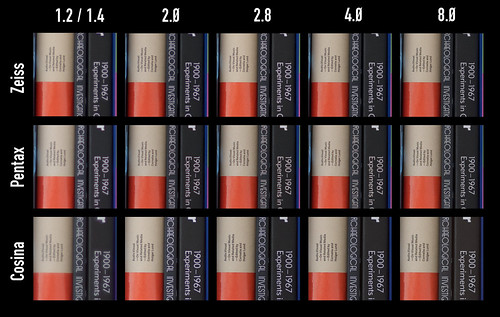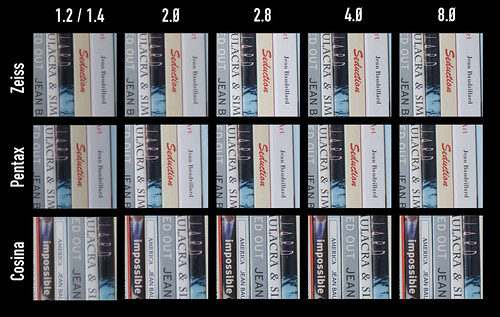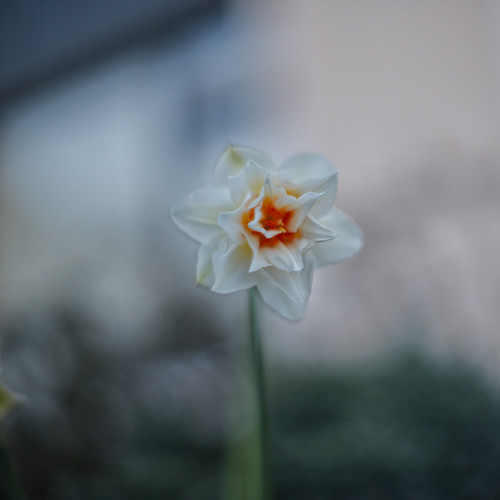I've been slowly going through my older lenses and seeing what works best with my Lumix S5. Historically, most of my photography has been on Pentax APS-C and Micro-Four-Thirds formats. A vintage lens made during the film era is more suitable for a full-frame sensor in terms of coverage, but any issues will show up more plainly.
With that in mind, I decided to perform a quick comparison of three lenses I have on hand: Cosina 55mm 1:1.2 MC, SMC Pentax 50mm F1.2, and Zeiss Planar T* 50mm f/1.4.

The Cosina 55mm 1:1.2 MC for K-mount is 44mm long and 325g. It takes 58mm filters. The aperture ring has stops at F1.2 and F2, then single stops to F16. The open aperture F1.2 is on the right side of the ring. There are 9 aperture blades. Unlike the full metal build of the other brands, the Cosina has a rubber focus ring. This detracts from the impression the lens gives, but might be useful if you shoot in cold environments.
The history of this lens is intriguingly complicated. Tomioka originally designed these lenses for M42 screw mount, and branded them as Tominon, Cosinon, Revuenon, Yashinon, and Chinon. Only a few were sold between 1970 and 1974, so they are now highly collectable, selling for €1300.
Cosina then bought the designs but changed the optical formula, marketing new variants, the most common of which is the Porst Color Reflex MC AUTO 55mm 1:1.2. You can buy one for only €225, the cheapest option for a very fast 50.
The third generation were Cosina's own optics, different again from the previous. These were marketed for K-mount as Revuenon (again!), Rikenon, and Vivitar Series I. Cosina has a long heritage of camera and lens manufacturing and so should not be considered inferior to Tomioka. In fact they have very collectable lenses of their own under the Voigtländer brand. The lens I have here fetches €500. Soon we will see if it is worth that price.
Though the names of the first and third generations are sometimes identical, it is easy to tell them apart. The first generation have the name "Tomioka" emblazoned on the lens rim, have a 9 blade aperture and a 58mm filter ring. The third generation of Cosinas have 8 blades and a 55mm filter.

The SMC Pentax 50mm F1.2 was in production for the K-mount from 1975 to 1984. It's one of many highly regarded 50mm lenses that Pentax released. In 1984 it was replaced by the SMC Pentax-A 50mm F1.2 which is identical except for an automatic aperture coupling. This remained in production until 2004, when Pentax finally brought out lenses with auto-focus. The Pentax lens is slightly longer (49mm) and heavier (at 345g) than the other lenses in this comparison. It has a 52mm filter.
The aperture ring has an unmarked stop between F1.2 and F2 that is actually F1.7. From there it has stops and half-stops to F22. The open aperture F1.2 is on the right. There are 8 blades.
Current price is €350. You can expect to pay another €100 for the A variant, since the auto aperture feature adds value for Pentax DSLR owners.
The Zeiss Planar T* 50mm F1.4 was made for the Contax-Yashica mount starting in 1975. Zeiss is very exacting with their specifications, and makes clear that this is actually a 52.3mm lens with an angular field of view of 47°.
The lens is compact at 41mm length, mass 290g, filter ring 55mm. The aperture ring has full stops only from F1.4 to F16. The open aperture F1.4 is on the left (opposite to the two K-mount lenses). The aperture ring turns with less resistance than the others, but has friction enough to prevent accidental changes.
You can purchase a mint copy for around €250 for the original AE version and €350 for the subsequent MM version. This was not known to be improved other than the addition of the automatic aperture coupling (irrelevant for digital use), so the main difference is the lack of ninja star bokeh at wide apertures. The extra cost may seem unjustified, but the MM lenses have a reputation for being "better" across the line, even though only some models were improved.
Zeiss made a similar 50mm F1.7 lens starting in 1980 that has similar optical performance. But the build incorporates plastic, normally anathema to this company. The bokeh is more nervous and the lens doesn't focus as close. The price of around €140 makes this option more appealing!
All three lenses extend slightly at close focus distances. The filter rings do not rotate. The Zeiss and Pentax focus down to 45cm while the Cosina manages only 60mm. The optical formula in each case is 7 elements in 6 groups. In fact, the diagrams for the Zeiss and Pentax look very similar.
Comparison
To test these lenses in non-scientific fashion I took tripod shots of my bookshelf at a distance of about 120cm. For the first set I focused on the centre of the frame, using various apertures. I batch converted the original Raw files using Affinity Photo 2 with no processing applied. Real-world photos will look better, because the detail, contrast, and other aspects would be tweaked.
I took notes from the full-sized images but haven't shared all of those files. When you see the full frame it's clear that the Zeiss and Pentax demonstrate significant vignetting, as we would only expect, which clears up already by F2.8. The Cosina is already quite clear at F2, which is surprising! Though vignetting can quite easily be corrected in software, the darker image skews exposures.
To create the following grid I took a 500 pixel square crop from the centre of each photograph. Click through to see the full-sized image on Flickr.

Looking first at the wide open image, the Pentax has significant halation and purple fringing. I am surprised to see that the Cosina has fewer of these artefacts. The Zeiss has the best image with already sufficiently sharp text and very little colouration.
As the Zeiss is stopped down it improves only slowly at first. F2.8 is tidier but the best image is reserved for F8. The Pentax improves significantly at F2, sharper than the Zeiss (which I now suspect may not have been focused perfectly). All the purple fog has gone. At F2.8 the text is crisp. At all stopped down apertures it beats the Zeiss marginally but obviously. I am not surprised, since Pentax has always been one of the very finest lens manufacturers.
The Cosina is also nice and tidy at F2 and to my eyes produces the best image in terms of sharpness, contrast, and detail throughout the aperture range.

For the next series (image above) I focused on the extreme right of the frame, or at least as close as I could get the 10x magnification to work. Here the significant difference in angle of view is obvious. In fact, it appears to me as though the Cosina might be closer to a 60mm focal length than the stated 55mm.
The Zeiss becomes useful at F2.8 and is very nice at F8. The Pentax is very close but lags behind. The Cosina again suddenly snaps into clarity with F2.8 and then improves slightly from there. I was surprised that this behaviour was so consistent across the lenses.
This test is somewhat artificial, since one rarely focuses on the edge of the frame. It's useful for seeing the absolute quality of the glass, but doesn't reflect field curvature. So I had a look at the frame edge on the first set of photos, where I had focused on the centre. I only checked out the F8 photos, since I would always be stopping down if I desired an image to be sharp corner to corner. The Zeiss seemed ever so slightly more accurate than the Pentax. But the Cosina seemed to have a further advantage of acuity and contrast.
Finally I turned to a shot that would test depth of field. I focused on the tip of the petal that is both lowest in the image and closest to the camera. The focal distance is about 60cm. (In retrospect I should have lit the subject more clearly.)
In order to show more context, each crop is now 1000 pixels square.

All the observations from the bookshelf still hold. But now we can see how the bokeh compares. The Zeiss is the most nervous, which agrees with my usage. The Pentax is smoother and more pleasant. Even at F8 I prefer how it renders the greenery that is behind the plane of focus. In truth, this is a torture test for any lens! The Cosina wide open has more definition to the bokeh, with outlines around the circles. It's a matter of taste as to whether that is desirable. Stopped down, the background is smoother than the others, but this is largely (if not entirely) the product of the longer focal length.
Conclusions
What did I want out of this comparison? Simple: I wanted the Zeiss Planar to win! I love the ease-of-use of this lens. The aperture moves smoothly, the markings are elegant, the way the two rings (focus and aperture) match texture is refined. And it's the smallest of the lot. As industrial design the Contax Zeiss range is matched only by certain Leicas.
But the photos I've taken, while perfectly good, lack the magic of my best optics. Maybe I need to give it more time, but today's test indicates that I already have better options to hand.
I have great respect for the range of lenses Pentax initially made for their K1000, the first camera to showcase the K-mount after they moved from the M42 screw mount. I have long assumed that the most expensive of the so-called Pentax-K 50mm lenses, the F1.2, would be the best possible 50mm.
My Cosina has been sitting in a drawer but I need to rethink this state of affairs! Because this lens has emerged as the sharpest of the three, with a better image wide open and a better image at the edges when stopped down. The bokeh may not be as ultimately smooth as the Pentax, but it is perfectly lovely. And I personally prefer the slightly longer reach.
Since I have no photos to share from the Cosina, I will instead demonstrate just how special the wide open Pentax can be. If you are a bokeh fanatic, take note!

5 comments:
I've read online that the earlier Tomioka 55/1.2 and the later Porst 55/1.2 are *not* the same lens, apparently the earlier consisted of 7 elements, while the later used six elements.
I have a Porst 55/1.2 for Pentax K mount but haven't removed the lens groups to confirm or deny, although I did file in clicks for half-stops into the aperture ring, not that you'd use this lens closed down often.
Even if it may have just six elements, mine is a good performer considering the age and the very fast aperture. It actually can resolve fine detail wide open, but there's a "glow" overlaid. To me it's a speciality lens for when you want to have visible background separation on a subject that's a few meters away. More close up it's not very useful, depth of field is just too thin for three-dimensional objects and a 50/1.4 or 50/1.7 would do just as well.
Exactly, they are not the same lens. There are three generations, with different optics. The Porst Color Reflex is the least expensive and considered the least interesting performer. The third gen (tested) are remarkably good. The first gen I have not used... but they cannot possibly justify the silly money they sell for. As always, rarity is an important factor.
P.S. I have updated the text to make the differences between the generations more obvious. Thanks for your comment!
I am amazed at the generosity you and others display by doing these reviews and comparisons. Camera geeks/snobs appreciate it!
Thanks so much. Every bit of encouragement helps!
Post a Comment